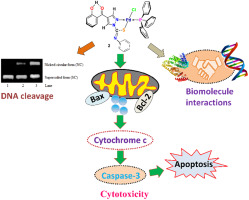当前位置:
X-MOL 学术
›
J. Inorg. Biochem.
›
论文详情
Our official English website, www.x-mol.net, welcomes your
feedback! (Note: you will need to create a separate account there.)
Unprecedented formation of palladium(II)-pyrazole based thiourea from chromone thiosemicarbazone and [PdCl2(PPh3)2]: Interaction with biomolecules and apoptosis through mitochondrial signaling pathway.
Journal of Inorganic Biochemistry ( IF 3.8 ) Pub Date : 2020-01-03 , DOI: 10.1016/j.jinorgbio.2019.110988 Jebiti Haribabu 1 , Chandrasekar Balachandran 2 , Manoharan Muthu Tamizh 3 , Yuvaraj Arun 4 , Nattamai S P Bhuvanesh 5 , Shin Aoki 6 , Ramasamy Karvembu 7
Journal of Inorganic Biochemistry ( IF 3.8 ) Pub Date : 2020-01-03 , DOI: 10.1016/j.jinorgbio.2019.110988 Jebiti Haribabu 1 , Chandrasekar Balachandran 2 , Manoharan Muthu Tamizh 3 , Yuvaraj Arun 4 , Nattamai S P Bhuvanesh 5 , Shin Aoki 6 , Ramasamy Karvembu 7
Affiliation

|
Two novel pyrazole based thiourea palladium(II) complexes, [PdCl(PPh3)(C9H8NO2S-pz)] (1) and [PdCl(PPh3)(C14H10NO2S-pz)] (2) [pz = pyrazole (C3H2N2)] have been obtained unexpectedly from chromone thiosemicarbazones (L1 and L2) and [PdCl2(PPh3)2]. The compounds have been fully characterized by physicochemical studies. The single crystal X-ray diffraction and spectral studies revealed square planar geometry for the complexes. The conversion of chromone thiosemicarbazone into pyrazole based thiourea might have happened through coordination to palladium(II) ion after enolization, Michael addition and ring opening followed by cyclization. To the best of our knowledge, this is the first report for the conversion of chromone thiosemicarbazone into pyrazole based thiourea moiety. Plausible mechanism was proposed based on the spectroscopic studies. Calf thymus (CT) DNA binding of the compounds was explored using various spectroscopic and molecular docking methods. DNA cleavage studies suggested that complexes 1 and 2 had the capacity to cleave the supercoiled DNA (pUC19) to its naked form. In vitro cytotoxic property of the ligands and complexes has been evaluated against three human cancer cells such as A549, HepG-2 and U937. Complex 2 exhibited potent cytotoxic activity against HepG-2 cells with the IC50 value of 10.4 μM. In addition, mechanistic studies showed that complex 2 induced apoptosis through mitochondrial signaling pathway in HepG-2 cells. Beneficially, complex 2 showed less toxicity against human lung (IMR90) normal cells and hence it emerges as a potential candidate for further studies.
中文翻译:

前所未有的从色酮硫半脲和[PdCl2(PPh3)2]形成钯(II)-吡唑基硫脲:通过线粒体信号传导途径与生物分子相互作用和细胞凋亡。
两种新型的吡唑基硫脲钯(II)配合物[PdCl(PPh3)(C9H8NO2S-pz)](1)和[PdCl(PPh3)(C14H10NO2S-pz)](2)[pz =吡唑(C3H2N2)]出自色酮硫半咔唑(L1和L2)和[PdCl2(PPh3)2]。该化合物已经通过理化研究充分表征。单晶X射线衍射和光谱研究揭示了络合物的正方形平面几何形状。苯甲酸酯化,迈克尔加成和开环后环化后,色氨酸硫代半脲转化为吡唑基硫脲可能是通过配位到钯(II)离子而发生的。据我们所知,这是第一个将色酮硫半脲转化为吡唑基硫脲部分的报道。根据光谱学研究提出了合理的机理。使用各种光谱和分子对接方法探索了小牛胸腺(CT)与化合物的DNA结合。DNA切割研究表明,复合物1和2具有将超螺旋DNA(pUC19)切割成裸露形式的能力。已经评估了配体和复合物对三种人类癌细胞如A549,HepG-2和U937的体外细胞毒性。复合物2对HepG-2细胞表现出有效的细胞毒性活性,IC50值为10.4μM。此外,机理研究表明,复合物2通过HepG-2细胞中的线粒体信号传导途径诱导凋亡。有利地,复合物2对人肺(IMR90)正常细胞的毒性较小,因此有可能成为进一步研究的潜在对象。
更新日期:2020-01-04
中文翻译:

前所未有的从色酮硫半脲和[PdCl2(PPh3)2]形成钯(II)-吡唑基硫脲:通过线粒体信号传导途径与生物分子相互作用和细胞凋亡。
两种新型的吡唑基硫脲钯(II)配合物[PdCl(PPh3)(C9H8NO2S-pz)](1)和[PdCl(PPh3)(C14H10NO2S-pz)](2)[pz =吡唑(C3H2N2)]出自色酮硫半咔唑(L1和L2)和[PdCl2(PPh3)2]。该化合物已经通过理化研究充分表征。单晶X射线衍射和光谱研究揭示了络合物的正方形平面几何形状。苯甲酸酯化,迈克尔加成和开环后环化后,色氨酸硫代半脲转化为吡唑基硫脲可能是通过配位到钯(II)离子而发生的。据我们所知,这是第一个将色酮硫半脲转化为吡唑基硫脲部分的报道。根据光谱学研究提出了合理的机理。使用各种光谱和分子对接方法探索了小牛胸腺(CT)与化合物的DNA结合。DNA切割研究表明,复合物1和2具有将超螺旋DNA(pUC19)切割成裸露形式的能力。已经评估了配体和复合物对三种人类癌细胞如A549,HepG-2和U937的体外细胞毒性。复合物2对HepG-2细胞表现出有效的细胞毒性活性,IC50值为10.4μM。此外,机理研究表明,复合物2通过HepG-2细胞中的线粒体信号传导途径诱导凋亡。有利地,复合物2对人肺(IMR90)正常细胞的毒性较小,因此有可能成为进一步研究的潜在对象。











































 京公网安备 11010802027423号
京公网安备 11010802027423号